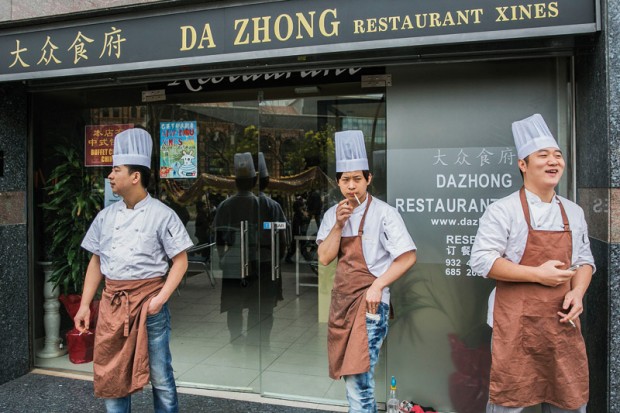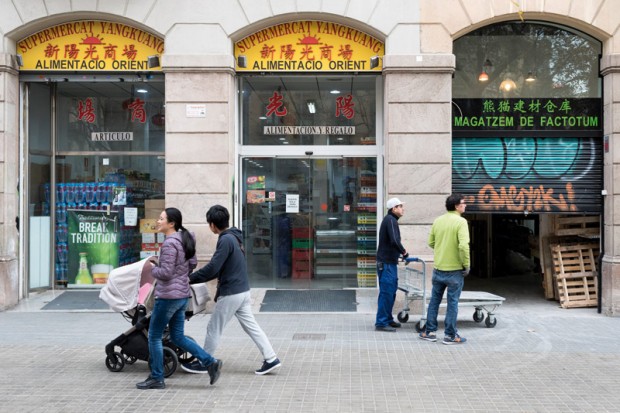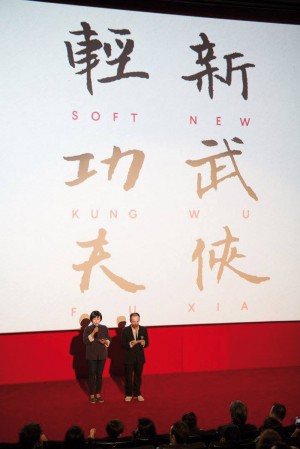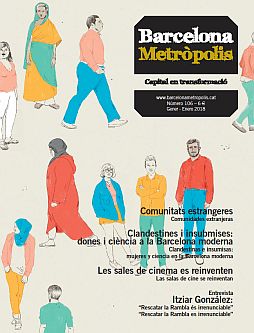
Cooks at the Dazhong restaurant in Carrer de Ribes, taking a break in the doorway of the establishment to watch the Chinese New Year Parade in February 2014.
Photo: Pere Virgili
In contrast to what happened with other migratory communities, the economic recession didn’t cause the sacrificed, money-saving and hard-working Chinese inhabitants of Barcelona to return home or leave for other destinations: the immense majority of them remained. The recession only slowed their arrival.
Between Mar Bella Beach and El Camp de la Bota, during the last few decades of the 19th century, a shantytown appeared on a stretch of beach known as Platja de Pequín. We don’t know for sure if the inhabitants were Chinese people from Cuba or Manilla or Tagalogs from the Philippines. Isidre Nonell left us an image of the community in 1901 with a beautiful, misty painting entitled La platja de Pequín, kept in the museum of Montserrat monastery. With the new waves of immigration resulting from the Universal Exposition of 1929, this oriental placename was almost forgotten. Some stories in the magazines Imatges or Mirador, with magnificent photographs by Gabriel Casas, show that there were several dozen Chinese people living in Barcelona in the 1930s who were dedicated to street peddling.
The first Chinese restaurant in Barcelona, El Gran Dragón, was opened in 1958 at number 5, Carrer Ciutat, right next to City Hall. It was opened by Father Peter Yang, a priest who left China with Mao Zedong’s triumph, and who said mass every morning at Barcelona Cathedral from 1965 onward, for over four decades. The second restaurant, Pequín, was opened by Kao Tze Chien (the cook from Father Peter Yang’s restaurant) with the savings he earned in 1962 by serving as an extra in 55 Days at Peking, filmed at Las Rozas, near Madrid. His descendants still run one of the best Chinese restaurants in the city.
In 1990, the 387 Chinese individuals registered in Catalonia, almost all in Barcelona, were still principally dedicated to the restaurant business. A large number had arrived over the last few decades from Taiwan. The 1992 Olympics served to attract Chinese people from all over, but most began to arrive from a very specific area in Zhejiang province, south of Shanghai: the rural Qingtian region, near the city of Wenzhou. This is the origin of the immense majority of Chinese people in Southern Europe, as well as those in Barcelona.
In a visible but still-gradual manner, the number of Chinese people and restaurants began to grow throughout the country. It was at the end of the ‘90s when the occupations of this community began to diversify, with the appearance of 100-pesseta bazaars, clothing and leather wholesalers in the Trafalgar area, or textile workshops in Badalona, Santa Coloma or Mataró.
Starting around the year 2000, this initial diversification opened up the possibility of an extremely rapid growth in Barcelona’s Chinese community. With an admirable capacity for adapting to new sectors and new demands, Chinese-run cybercafés, hair salons, manicure salons, clothing stores and greengrocers began to appear. Many Chinese people also took over existing bars, without changing either their names, the decoration or the repertory of tapas and drinks.

Chinese establishments on Passeig de Sant Joan, in the Arc de Triomf area, which in recent years has seen a considerable surge in businesses run by families from the Asian giant.
Photo: Dani Codina
Growing economic importance
Beyond these commercial sectors in constant mutation and the businesses aimed primarily at the Chinese community itself (administrators, sworn translators, Chinese supermarkets, wedding photographers, travel agencies, driving schools…), Chinese people in Barcelona are starting to gain economic importance: they channel Chinese investments while opening exporting companies that place our local goods and services (our olive oils, wines or football clubs) in the Chinese market. The international projection of the vibrant Chinese economy and the consumer potential of the Chinese market find the Chinese individuals that live among us to be a bridge and a privileged point of access.
Municipal statistics from early 2017 tell us that there are some 20,000 Chinese people registered in the Catalan capital. It is the second-largest immigrant community, a ways behind the much larger Italian community and a little above the similar number of Pakistanis. As opposed to what happened with other migratory communities, the economic recession didn’t cause the sacrificed, money-saving and hard-working Chinese inhabitants of Barcelona to return home or leave for other destinations: the immense majority of them remained. The recession only slowed their arrival, which nevertheless hasn’t stopped.
A scattered population
Even though the over 50 million Chinese people living abroad tend to concentrate in colourful Chinatowns that concentrate most of the population and most ethnic Chinese commerce in a specific urban space, in the case of Barcelona the Chinese population is quite scattered. Nearly 30% of Chinese people live in the Eixample, while 19% live in Sant Martí and 13% live in Sants-Montjuïc, which are followed by Sant Andreu and Nou Barris, each with populations of around 8%. This scattered population can be explained with the also-scattered initial growth of the community, which was first dedicated to businesses aimed at the city as a whole (restaurants and bazaars) that preferred to locate themselves as far away as possible from the competition.
In recent years, in the Fort Pienc neighbourhood and the lower Dreta de l’Eixample, around the Passeig de Sant Joan and Arc de Triomf, there has been an increase in the commercial concentration and visibility of the Chinese. The Chinese community has a metropolitan dimension that goes beyond the strict borders of the city, and line 1 of the metro connects the Arc de Triomf area with the Fondo neighbourhood (between Badalona and Santa Coloma), where there is enough of a concentration of Chinese population and businesses to constitute an embryonic Chinatown. This good connection has contributed to the concentration of Chinese people in this area.
In these two areas where the Chinese community of Barcelona is most visible, the municipal Xeix project (which also works with Pakistani communities) has developed. This is an exemplary project with European support, which has managed to integrate Chinese shopkeepers into the shopkeepers’ associations of their respective neighbourhoods. With a high level of participation, the project has helped to break stereotypes and suspicions. The Xeix project has also promoted the importance and the participative initiative of Chinese people in the neighbourhood through educational, cultural and celebratory activities. The Chinese New Year parades are only the most visible example of this.
A notable associative instinct
One of the distinctive traits of the Chinese mercantile diaspora, including that of Barcelona, is a strong associative instinct. There are several dozen Chinese associations in the city: associations of women, shopkeepers or compatriots, or educational and religious associations (a large part of the Chinese community in Barcelona practices Christianity in protestant Chinese churches). The strength of a big family, trust in compatriots and associative support help to explain the entrepreneurial capacity of a community that is connected in a network with all of its sister communities in Europe and with the Chinese regions they originally hail from. Mutual trust helps to bring down the cost of transactions, making immigrants more competitive, resilient and efficient in fulfilling their dream of being able to open their own family business. In recent years, the Chinese consulate has shown a great deal of interest in strengthening (and, meanwhile, in controlling) these associations, funding educational, commercial and cultural activities that have begun to open up to the city as a whole.
The virtual social networks (WeChat, Weibo, QQ…) used by the Chinese inhabitants of Barcelona have created information channels that go beyond the impact of paper newspapers published in Chinese in the Iberian Peninsula, whose offices have been in Barcelona for over a decade. These new digital formats strengthen community activities and the knowledge of what happens in the city and nationally. At the same time, all of this is part of a global migratory network, which is interconnected with transnational businesses and families.
Much of the Chinese community in Barcelona arrived recently, and it is young and diverse. This is the community that sends the most new students to the city’s school system. Plus, on weekends there are several schools in the city where Chinese children study Chinese. Learning to master Chinese writing requires such an investment in time that spontaneously learning the language in a family setting isn’t enough. On the other hand, most Chinese people in Barcelona don’t have standard Mandarin Chinese (based on the language of the capital, Beijing) as their mother tongue, instead speaking a regional variant of the Wu languages.

Inauguration of the first edition of the Lychee Film Festival, Barcelona’s Chinese film festival, which was held last September in various cinemas in the city.
Photo: Lychee Film Festival
Legends and rumours
Chinese people in Barcelona see themselves unfairly associated with all manner of urban legends and absurd rumours. They are automatically associated with sensationalist and completely inaccurate concepts like the “Chinese mafia” (theirs is a community with a very low index of criminality, meaning that this urban legend has nothing to do with the immense majority of its members), or the false idea that they don’t pay taxes. An equally ridiculous legend states that when they die, where their remains go is a mystery (the same has been said of the Chinese communities of Paris and London). Chinese burials and interments are perfectly well-documented, but furthermore most Chinese people in Barcelona are young— we haven’t even given them time enough to die. In addition, many aim to return to China (and some of the older generation has begun to do so) in their later years, and to be buried in Chinese soil.
The legend states that the Chinese are a closed community, but that isn’t so: first-generation immigrants have spent so much time and effort working that they haven’t had either the time or the incentive to relate with those outside the community. Also, learning our languages has proven as difficult to them as learning Chinese would to us. However, Chinese people who have opened businesses where the interactions with customers go beyond simply charging them for the merchandise, such as hair salons or bars without an ethnic Chinese audience –bars where you can get a coffee or a beer, a tapa and a sandwich– have shown that they are capable of learning their customers’ names in a short period of time, that they make small talk, and that they know how to win customers’ loyalty.
That doesn’t mean that the Chinese don’t maintain a strong sense of ethnic and cultural belonging wherever they go. However, this is no obstacle to their participation in the social and cultural fabric of the city. The hundreds of young Chinese university students in Barcelona and the hundreds of young people who have grown up and been educated here include very active individuals: proof of this is the first edition of the Lychee Chinese Film Festival held in September 2017. It was promoted by young Chinese people who have already set up several events at the Centre de Cultura Contemporània de Barcelona (CCCB), among other spaces.



